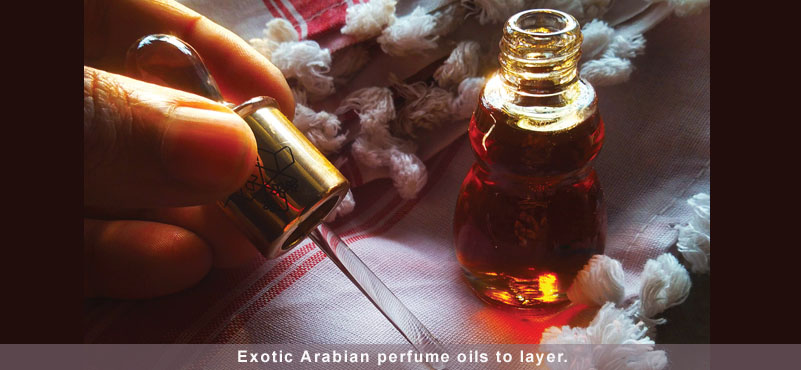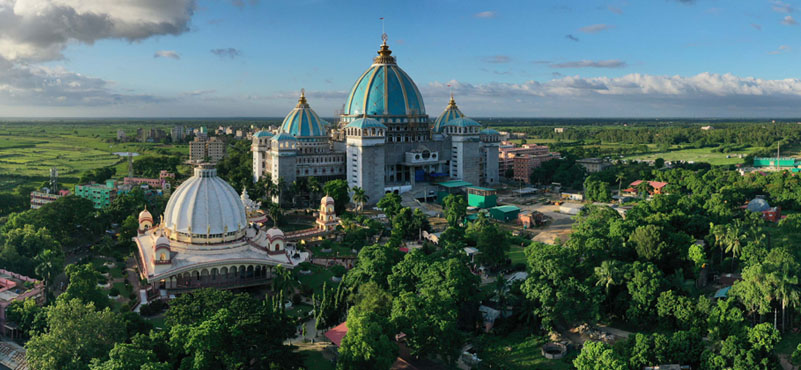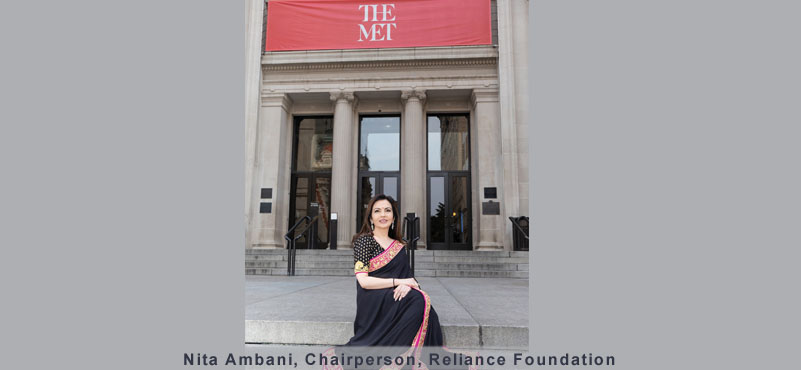The scent synonymous with the Sheikhs, originated in India. We explore the saga of Oud, that protective resin that has come to be known as agarwood.
Dashing past in a split second, he leaves you spell bound as aromas of musk accompanied by woody, spicy overtones escape his sparkling white robe. Even several minutes past roaring away in his silver Hummer, the aromas hang in the air, creating olfactory magic in the five star atrium. You can’t help but soak them in!
Apart from dune-bashing and the glass and concrete glitz, one subtly captivating experience visitors to Dubai often cherish, is that of the perfumes of the city’s indigenous rich! However, that magical scent the Arabs of the Gulf have passionately obsessed over for centuries, finds its origins in the verdant wonderland of Assam. The ancient Sanskrit texts call it ‘Agar’, in Arabic, it’s ‘Oud’ or simply, ‘wood’. Today, oud is a newfound fascination among fragrance aficionados globally.
Even Shakespeare couldn’t resist a reference to the ‘perfumes of Arabia’ when in Macbeth, Lady Macbeth cries “…all the perfumes of Arabia will not sweeten this little hand”, referring to the intense exoticism Arabia’s perfumes owe, to the magic of oud!
Historic Musings
“Several millennia ago, our ancients first discovered agar or agarwood as a versatile fragrant ingredient that possessed both, the power to enchant with its unique aromas, and to heal with its inherently medicinal properties” explains veteran perfumer Mr. Mukul Gundhi.
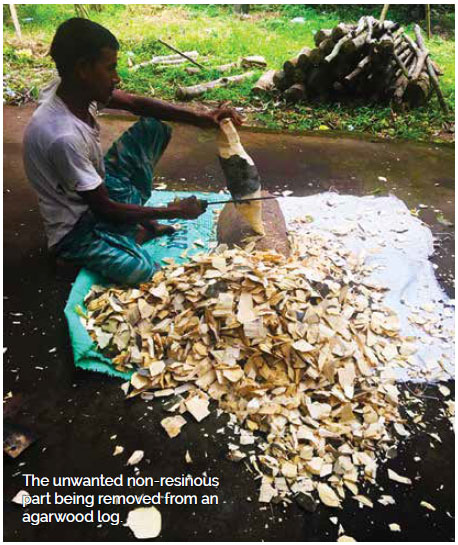 At his 207 year-old quaint heritage perfumery Gulabsingh Johrimal 1816 in Old Delhi’s bustling Dariba Kalan, a viscous, deep black oil finds place in an ornate Belgian-cut perfume jar. “The Arabs call this oil Dahn Al Oud or ‘fat of the wood’” he explains. The west, he says, calls it ‘liquid gold’. “While agarwood is a pivotal ingredient in Arabian perfumery, Ayurveda talks about its medicinal value. It is also mentioned in the Bruhad Samhita and the Ashtagandh” says Mr. Gundhi. Leathery, animalic, spicy, woody and musky, the oil’s unusual scent profile is captivating as it grows on you with even just a dab on the skin.
At his 207 year-old quaint heritage perfumery Gulabsingh Johrimal 1816 in Old Delhi’s bustling Dariba Kalan, a viscous, deep black oil finds place in an ornate Belgian-cut perfume jar. “The Arabs call this oil Dahn Al Oud or ‘fat of the wood’” he explains. The west, he says, calls it ‘liquid gold’. “While agarwood is a pivotal ingredient in Arabian perfumery, Ayurveda talks about its medicinal value. It is also mentioned in the Bruhad Samhita and the Ashtagandh” says Mr. Gundhi. Leathery, animalic, spicy, woody and musky, the oil’s unusual scent profile is captivating as it grows on you with even just a dab on the skin.
It is believed that during the Indus Valley Civilization, the process of distilling natural fragrant materials to acquire perfume oil was first discovered. Agarwood is native to Assam and also to Cambodia, Thailand and other South East Asian regions. However, Indian oud finds mention also in the Islamic Hadith as ‘Oud Al Hindi’. The Old Testament speaks about it as ‘Aloes’ or ‘Aloeswood’. The world’s oldest-known agarwood source remains India.
Labour of Love
In the endless lush green expanse of Assam, the most sought-after tree species is the Aquilaria Agalocha. When infection or injury strikes the tree, it secretes a protective resin which turns into agarwood.
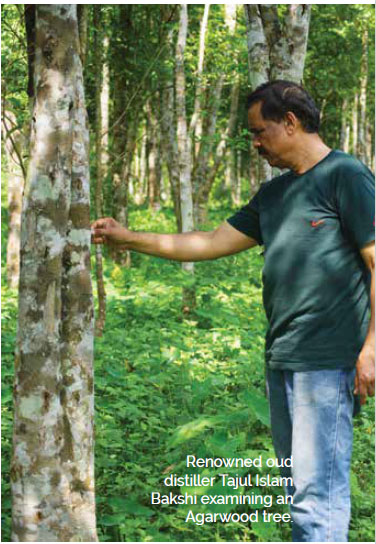 One of the world’s most respected agarwood distillers is Assam-based Mr. Tajul Islam Bakshi of Assam Aromas. Specializing in sophisticated artisanal oud, he believes that it takes herculean effort and grueling labor to give birth to this mystical scent. “Oud is today, considered the world’s most exotic fragrance, not only by the Arabs but the world-over. I have clients from all faiths, nationalities and backgrounds who even wear the oil and burn the wood as incense, purely for meditation” he says. Oud, he believes, finds mention in nearly all cultures and is ‘humanity’s fragrant binder’.
One of the world’s most respected agarwood distillers is Assam-based Mr. Tajul Islam Bakshi of Assam Aromas. Specializing in sophisticated artisanal oud, he believes that it takes herculean effort and grueling labor to give birth to this mystical scent. “Oud is today, considered the world’s most exotic fragrance, not only by the Arabs but the world-over. I have clients from all faiths, nationalities and backgrounds who even wear the oil and burn the wood as incense, purely for meditation” he says. Oud, he believes, finds mention in nearly all cultures and is ‘humanity’s fragrant binder’.
“When the sick tree is harvested, the resinous and non-resinous parts are separated. The most resin-rich part goes through a finishing process and its chips are sold as incense which the Arabs call ‘Bakhoor’. ‘Curving dust’ consisting of both resinous and non-resinous parts, is distilled to yield the oil or Dahn Al Oud. Since the chips cost more than the oil, distilling all the resinous part would be economically unfeasible.” Mr. Bakshi explains.
A Global Aroma
Agarwood trees are also found in Assam’s neighboring north eastern states like Meghalaya, Manipur, Tripura, Mizoram and Nagaland. Many of them are said to be over a century old. Although it takes years, sometimes decades for a tree to be infected by natural causes, the process of artificially infecting a tree through inoculation is often practiced, for quicker commercial yield.
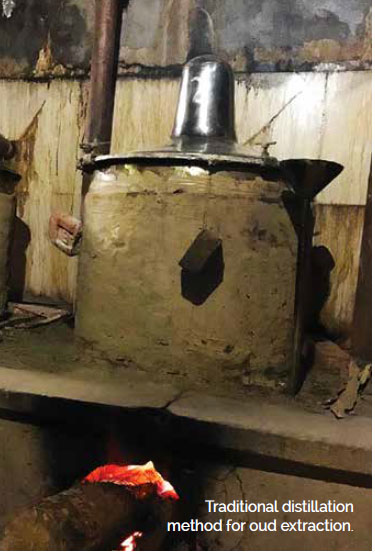 It is believed that there are a few thousand agarwood distillers in Assam, the seat of agarwood production. Here, it is considered a sustainable cottage industry that employs nearly a lakh of people from the local population, providing them with livelihood. These are highly trained and skilled workers specializing in the various stages of the process. Although afforestation remains a debated topic, many in the industry speak about replantation.
It is believed that there are a few thousand agarwood distillers in Assam, the seat of agarwood production. Here, it is considered a sustainable cottage industry that employs nearly a lakh of people from the local population, providing them with livelihood. These are highly trained and skilled workers specializing in the various stages of the process. Although afforestation remains a debated topic, many in the industry speak about replantation.
While there are numerous agarwood plantations owned by the distillers themselves, many distillers offer services to plantation owners who complete the harvesting and pre-distillation processes before sending them for distillation.
Indian Oud as its globally known, has spread its ethereal aromas beyond India’s boundaries over the years. Notwithstanding the export of agarwood falling under the regulations of CITES (Convention on International Trade in Endangered Species of Wild Fauna and Flora), India and the Middle East have enjoyed a longstanding trade relationship.
There was a time when, from the 70’s until the late 90’s, Mumbai (formerly Bombay) was the agarwood hub. White robes and bright red Shemaagh headscarves merging with Colaba’s kaleidoscope of black and yellow cabs, the grey Arabian sea and the multicolored bazaars was never a surprising sight. In the economic capital’s fragrance markets of Nagdevi Street and Muhammad Ali Road, Arabs from the GCC countries would flock to purchase agarwood. Today however, the hub has moved to Dubai.
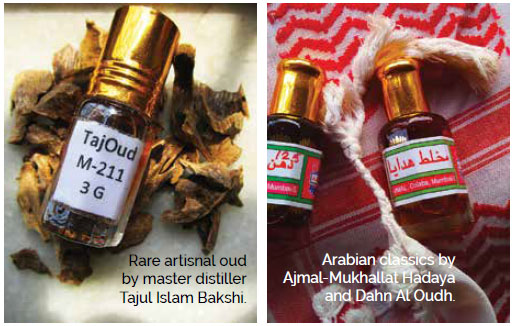 Although Indian agarwood, as both, oil as well as wood, commands a lofty position on the shelves of fragrance boutiques all over Saudi Arabia, Oman, Qatar, Kuwait and Bahrain, purchasing high-quality Indian oud and oud-based perfumes calls for a trip to the UAE for the sheer variety in perfumery innovation.
Although Indian agarwood, as both, oil as well as wood, commands a lofty position on the shelves of fragrance boutiques all over Saudi Arabia, Oman, Qatar, Kuwait and Bahrain, purchasing high-quality Indian oud and oud-based perfumes calls for a trip to the UAE for the sheer variety in perfumery innovation.
In recent times, internationally celebrated western brands like Tom Ford, Ralph Lauren, Armani and Chopard have made waves with their oud infatuation. No longer is ‘oud’ associated with Arab billionaires alone. “Today, every other high-end perfume coming out of the west bears oud on its label. French perfumers are making millions out of the oud tag. Their recent fascination for the rich, earthy aromas of our ancient fragrant treasure has inspired them to experiment with Dahn Al Oud and often, just an accord of it, or in other words, formulations that give the feeling of Indian oud in a perfume”, Mr. Mukul Gundhi proudly smiles.
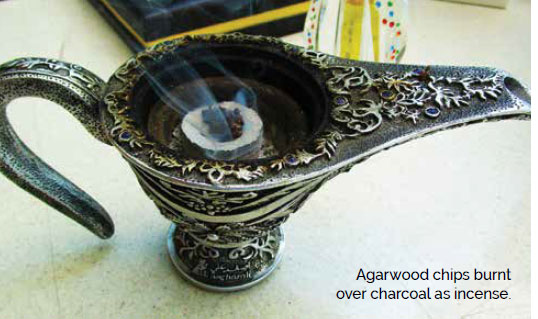 Painstaking Effort to Premium Luxury
Painstaking Effort to Premium Luxury
For centuries, oud has been a way of life with the Gulf Arabs. Their ability to wear the heady, ‘on-your-face’ scent and carry it off with panache has been a subject of much awe. “We perfume everything with oud.. hair, beards, cars and clothes ! Since there is an Islamic tradition of wearing oud and even gifting it, oud has today become the Arab World’s most high-end luxury product. Although Cambodian oud is gaining rapid popularity here, the most sought-after variety remains Indian oud” says senior Bahraini-Arab fragrance collector Mr. Abu Marwan.
Indeed, Indian oud is considered more expensive than gold. In India, one tola ( approximately 12 ml) of premium quality high grade oil would cost anything between 15,000 to 35,000 INR. In the UAE, just 3ml of pure oud oil would cost anything between 250-850 AED ( INR 5,000-19,000). The chips burnt as incense cost around a few lakh rupees a kilo. In addition to raw agarwood chips, ‘muattar’ incense in the form of artificially scented chips or agarwood powder are among the upper-crust oud products in the Middle East.
“In the Gulf, fragrance finds myriad expressions. Not only do Arab men and women wear Oud Al Hindi solo, they even layer it with their favorite fragrances in complex and intricate formulations. Through the art of blending Indian oud with complimenting notes like musk, amber, saffron and rose, they create hallmark ‘Mukhallat’ ( Arabic for ‘blended’) fragrances. These have catapulted Middle Eastern fragrance brands to insurmountable success ” explains Arab culture scholar Dr.Adel Ben Haj Yedder.
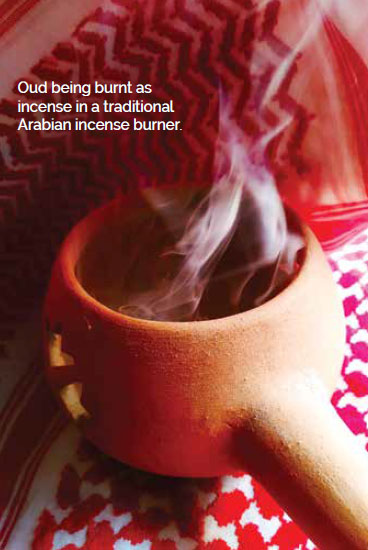 Indian oud has also played a pivotal role in oriental and now, French perfumery, adding grandeur to some of the world’s most gilt-edged fragrance oils and perfumes. While in the Gulf, Dahn Al Oud and oud-based perfumes are considered a royal indulgence, western perfumers are dabbling with oud’s powerful aromas to create among the world’s most expensive perfumes sold today.
Indian oud has also played a pivotal role in oriental and now, French perfumery, adding grandeur to some of the world’s most gilt-edged fragrance oils and perfumes. While in the Gulf, Dahn Al Oud and oud-based perfumes are considered a royal indulgence, western perfumers are dabbling with oud’s powerful aromas to create among the world’s most expensive perfumes sold today.
In the east, Gulf brands like the Saudi-based Abdul Samad Al Quraishi, Majid Iterji and Arabian Oud which boasts of a global presence, and UAE icons like Swiss Arabian and Al Haramain to name a few, have perfumed palaces with Indian oud. In the west, Tom Ford’s celebrated Tobacco Oud, Armani’s Eau de Nuit Oud, Chopard’s Oud Malaki and Ralph Lauren’s famed Polo Supreme Oud, though not apt examples of Indian oud per se, began the oud trend among the western masses in the last decade.
Oud has cast a spell even on perfume houses across Arabia’s neighbors. Turkey’s legendary Eyup Sabri Tuncer 1923, that celebrates its centenary this year, has paid ode to this ancient scent with its classic Indian Oud , a play of rose, amber, musk and oud.
Through its poignant journey from an infected tree in Assam’s hinterland to a millionaire’s closet, Indian oud has surely captured hearts across cultures. Despite its unaffordability, this mysterious, towering scent has become a fashion statement and a status symbol among fragrance lovers the world over more than ever before in history. With ever whiff, we celebrate and salute the undying efforts of all the dedicated artisans who tireless strive to make the world’s most exotic scent come alive!
ABOUT THE AUTHOR
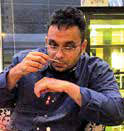 Krishnaraj Iyengar is a passionate writer, polyglot, perfumer and musician. Along with pursuing independent writing, he dabbles with fine fragrances and classical music. Being fluent in several Indian and international languages gives him a deeper cultural perspective to his diverse subjects.
Krishnaraj Iyengar is a passionate writer, polyglot, perfumer and musician. Along with pursuing independent writing, he dabbles with fine fragrances and classical music. Being fluent in several Indian and international languages gives him a deeper cultural perspective to his diverse subjects.

